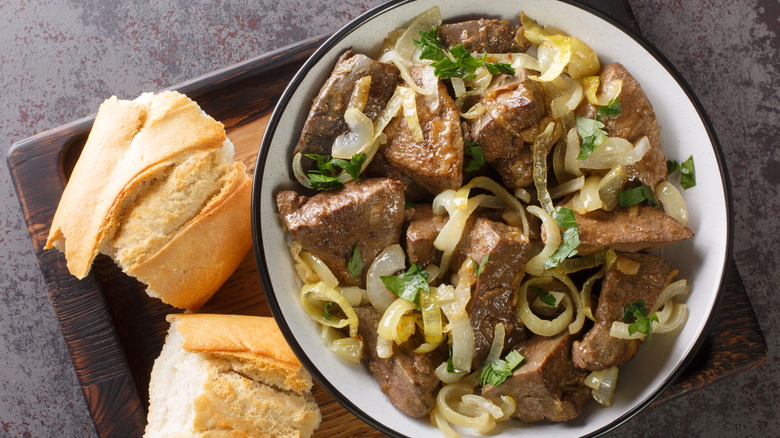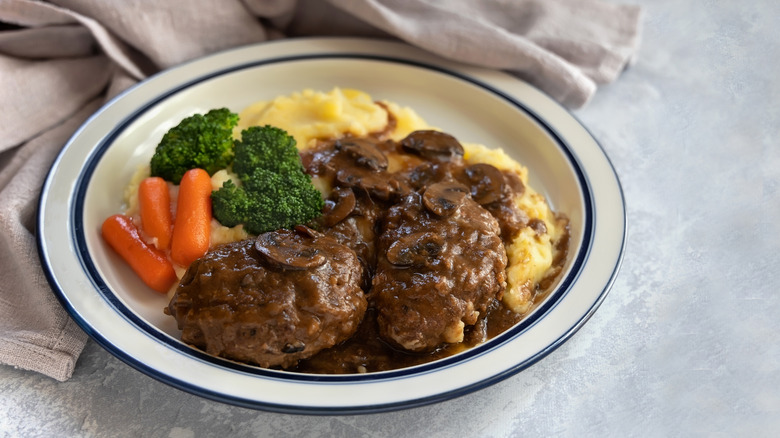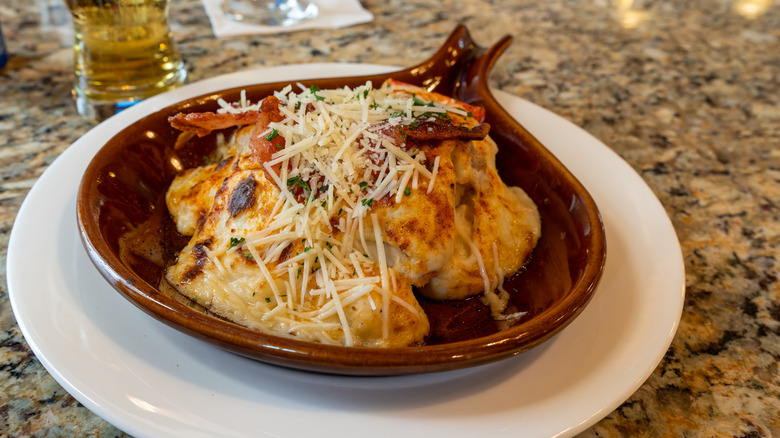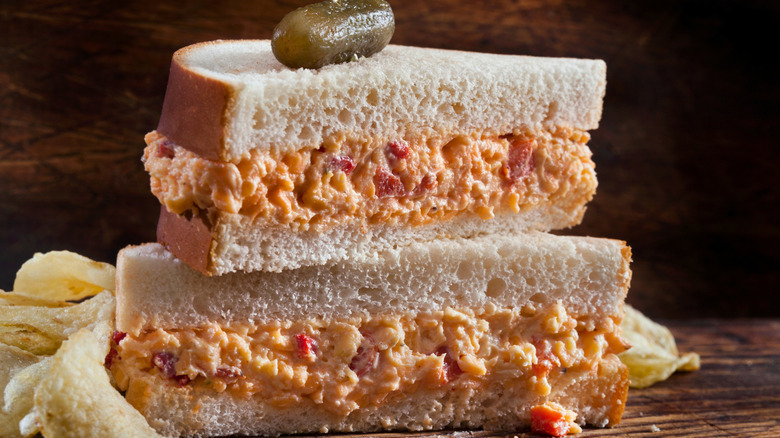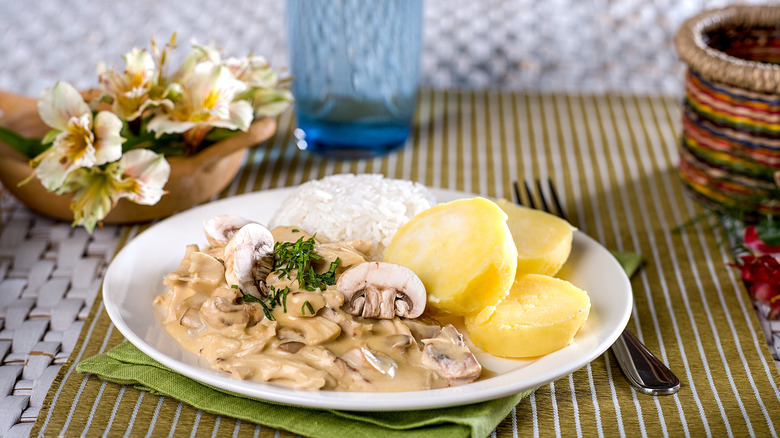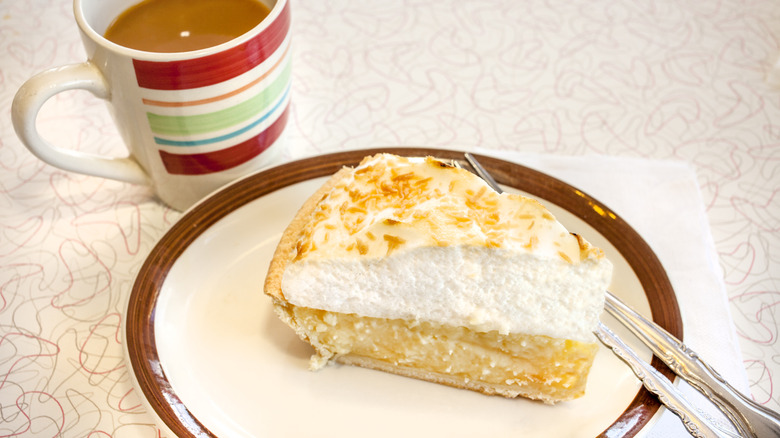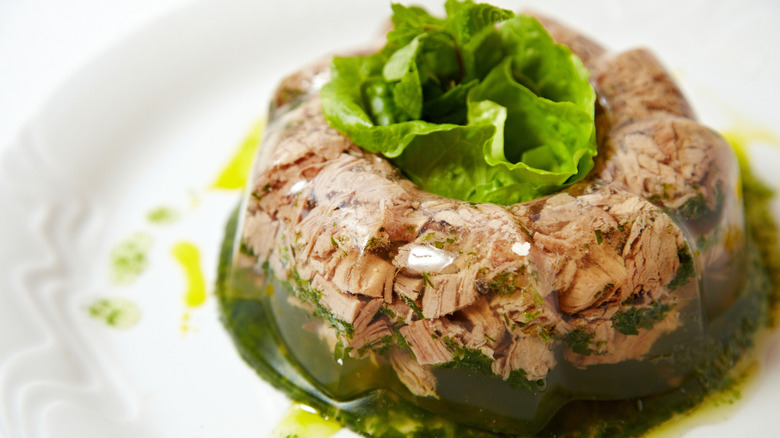Vintage Diner Foods That Just Aren't As Popular Anymore
The American diner is a big part of our culture. With its gleaming chrome, red vinyl booths, and a jukebox belting out classic tunes, the diner is a throwback to a bygone era, serving up hearty portions of no-frills food along with endless cups of coffee. While some staples (such as burgers and fries) have remained unchanged through the years, quite a few vintage diner foods that were once the rage have now quietly faded away.
Many of these classic diner staples were beloved by American consumers, but changing food trends and preferences have played a big role in their decline. Formerly popular dishes may now be considered too stodgy or too heavy, or they may have just fallen off the radar in place of trendier fare. Either way, these forgotten favorites offer us a glimpse into the past and provide a nostalgic trip into America's varied culinary history (and some give us reasons to demand their return!).
Tuna Casserole
At one time, the tuna casserole was the queen of quick weeknight dinners. Creamy and savory, topped with fried onions or potato chips to give it a crunch, it was the essence of a cozy meal. It first made an appearance in Sunset magazine back in 1930, and by the 1950s, it was riding the popularity charts. Tuna casserole became a perfect fit for a post-war America discovering its penchant for convenience foods and electric appliances. Canned tuna, along with cream of mushroom soup and egg noodles, was the ideal budget-friendly, belly-filling dish for working women. But it wasn't just a home-cooked thing. Plenty of diners and lunch counters offered it as a rotating special or a budget-friendly "blue plate" meal (and some old-school spots still do). Soon, there were countless versions available — each with a charm of its own. Some had peas or corn, others had white sauce and mushrooms, but all were filling and simple.
By the '80s and '90s, its appeal had begun to dull. Environmental issues like overfishing and sustainability, worries over high mercury content in tuna, and a growing awareness of the ill effects of high-sodium diets all contributed to its waning popularity as words like "organic", "fresh", and "health foods" became the new standard. Tuna casserole hasn't gone extinct as yet, but its rare sighting at dinner tables makes it an endangered species.
Liver and Onions
Liver and onions is a dish that belongs to the era of hearty suppers before vitamin supplements and fortified foods took over — when your dinner was expected to provide you with all the necessary nutrients, vitamins, and minerals. The origin of liver and onions is murky, though. Almost any culture that eats beef will have some type of liver dish on their menus, so nailing down the origins of this dish is a fool's errand. What we do know is that by the mid-century, it was a weeknight regular on American dining tables.
The unmistakable aroma of frying onions mixed with liver was a hallmark of grandma's kitchen or the neighborhood diner. The distinctive flavor of liver — bold and gamey, occasionally slightly sweet – meant that not everyone was a fan. It is one of those foods that you will either love or avoid at all costs. Calf and chicken liver are milder and considered more palatable than beef liver, but even these can be a hard sell to the younger generations. Nostalgia, however, runs deep, and some have fond childhood memories of the dish. Liver and onions may no longer be a staple available at your local diner, but the legacy lingers, and it remains a divisive yet deeply nostalgic dish.
Cincinnati Chili
Few regional dishes have the power to spark as much debate or confusion as Cincinnati chili. First created by a Macedonian immigrant, Tom Kiradjieff, in the 1920s, it was conceived as a clever marketing ploy to help boost sales at his hot dog stand, Empress Chili. It soon became a hometown obsession, and the rest is history.
Cincinnati chili is a meaty, tomato-based sauce seasoned with a mix of Middle Eastern spices that include cinnamon, allspice, and a hint of chocolate. It is ladled generously over spaghetti and topped with shredded cheddar, chopped onions, and sometimes beans. Locals have developed a complete terminology around it, with terms like "two-way", "three-way", and "five-way" bandied about. There is even a correct method to eating it, and twirling it with your fork is frowned upon.
Cincinnati chili is an iconic dish, and while it can be found outside its origin city at chains like Skyline Chili and diners across the country, outside the city, critics tend to be vociferous in their opinions. It's referred to as everything from the "worst regional foodstuff in America," to "disgusting," with some saying, "It was like spaghetti with sugar, and bad chili sauce."So while Cincinnati chili hasn't disappeared entirely, it hasn't penetrated much beyond its hometown and remains rooted there.
Egg Creams
If you've never had an egg cream, then the name might put you off. But this New York City classic contains no eggs and no cream – just fizzy, frothy chocolate that will delight anyone with a sweet tooth. It's one of those old-school soda fountain drinks that doesn't seem like much on the menu, but was a smash hit when introduced.
The generally agreed-upon story of its origin centers around Louis Auster, a candy store owner from the Lower East Side who whipped up this concoction using milk, chocolate syrup, and seltzer. The result was a frothy, creamy-looking drink with a head that resembled whipped egg whites, hence the name. Over the following decades, egg creams were everywhere, with competitors imitating the original drink. From Bronx candy shops to Brooklyn soda fountains, all establishments just had to serve it. Cheap and refreshing, it became an unofficial drink for generations of New York City kids. Then soda fountains started vanishing in the 1960s with the advent of bottled and canned drinks, and with this, the egg cream became an endangered species. Today, the drink is far from extinct, but it remains confined to a few retro spots and some diners, more of a nostalgic niche drink than a fan favorite.
Salisbury Steak
Salisbury steak may bring to mind meals eaten at the diner or microwaveable TV dinners, but at one point in time, it was considered to be healthy food — no joke. The origins of this dish lie in the American Civil War when Dr. James Salisbury, an early proponent of germ theory, prescribed chopped lean beef to Union soldiers suffering from digestive ailments. His theory was that broiled, lean beef patties would be far more nutritious and easy to digest than other starch-heavy foods. The solution worked, and the Salisbury steak, seasoned with Worcestershire sauce, mustard, horseradish, and lemon juice, was born.
By 1904, it was incorporated into the Navy's official cookbook as "Hamburger Steak," and over time, it evolved into a dish with a rich brown gravy and paired with vegetables and mashed potatoes. It was only post-WWII that it became a star of the frozen food aisle and diner meals everywhere. But times changed, and dietary preferences along with them. Concerns over too much red meat in the diet, the rise of plant-based eating, and the trend towards organic and fresh foods meant it lost its spot at the dining table. These days, you are more likely to find it in hospitals and cafeterias than at diners. But the Salisbury steak deserves some attention as one of the first "health" foods created by a doctor.
Turkey Devonshire
Technically a sandwich, the Turkey Devonshire is still something you will not want to pick up with your hands. Instead, this Pittsburgh original is meant to be eaten with a fork and knife. It is a rich, gooey, over-the-top affair that was created in the 1930s by local culinary legend, Frank Blandi. It was a hit with the city's movers and shakers, and looking at how it's made, it's easy to understand why.
Thick white toast is layered with freshly roasted turkey breast, topped with crisp bacon and drenched in a velvety cheddar cheese sauce. A generous sprinkle of parmesan cheese and paprika is added, and the whole affair is then baked in an oven until it is a lovely, bubbly, golden color. The cheesy, savory indulgence is a truly satisfying product of its age, a time when calorie-counting and lipid profiles were unheard of. By the '60s and the '70s, it was available all over Pittsburgh in restaurants and on diner menus. But the inexorable march of time brought with it the low-fat, health food era. To a generation raised on ancient grains, organic foods, and kale smoothies, the Turkey Devonshire seems like a fossil from a bygone age. But a few diners and delis still serve it, a nostalgic nod to the city's past and an indulgence that food buffs would still love to try.
Pimento Cheese
You've probably been hearing "pimento cheese this, pimento cheese that" of late. Dubbed the "caviar of the South," this creamy, tangy spread has been making the rounds again even though it's seen its fair share of highs and lows over the years. While the South has wholeheartedly adopted pimento cheese as its own, its roots actually trace back to New York during the Industrial Food Revolution. Originally made with cream cheese and canned pimientos, it evolved into the staple we know today, consisting of cheddar, cream cheese or mayonnaise, chopped pimentos, and maybe a little hot sauce for a kick.
Before World War II, it was everywhere. Diners served it as cold plate specials with two slices of white bread, a scoop of pimento cheese, maybe a few lettuce leaves, and kettle chips thrown in for a "balanced" meal. Fancy restaurants offered it as finger sandwiches or filled cucumber bites while housewives served it proudly at BBQs, potlucks, and packed lunches. Then, for no apparent reason, post-war, it vanished. But like all good retro food icons, it's been creeping back. In the 2010s, Southern bloggers and chefs reignited the trend, tapping into the appeal of affordable comfort food with nostalgic charm. And it's anyone's guess as to whether another revival is just around the corner, or whether it will eventually disappear into the history vaults for good.
Chicken à la King
Don't make the mistake of confusing Chicken à la King with chicken pot pie. Sure, both involve chunks of chicken and creamy white sauce, but à la King is something else entirely — dare we say a little bit more elegant and less rustic? A proper Chicken à la King features tender strips of white meat chicken in a silky sherry-based cream sauce. Mushrooms and peppers are the usual vegetable suspects, though some versions toss in peas or carrots. It's often served in puff pastry shells, over white rice, or with dainty toast points. Think diner food with just enough flair to feel fancy.
Despite the name, though, there's nothing royal about its origins. It was likely created to sound French and exotic. Delmonico's, the Brighton Beach Hotel, and the Plaza have all claimed credit. Still, the most widely accepted story attributes the dish to hotel cook William "Bill" King at the Bellevue Hotel in Philadelphia. Chicken à la King was a mid-century classic, the sort of thing that made you feel grown-up and sophisticated when you ordered it. We believe this is one diner meal that is due for a comeback. Because who doesn't want a plate of creamy, cozy, chicken-y goodness that feels just a little bit luxe?
Coconut Cream Pie
A slice of pie. You know the kind — served up in a red vinyl booth, paired with a steaming cup of black coffee. Think "Twin Peaks," where cherry pie was practically a supporting character. And sure, there's lemon meringue, key lime, apple, and (of course) cherry — but coconut cream? That one deserves its spot back on the counter, even though coconut's one of those ingredients you either love or hate.
Like most great pies, the magic is as much in the crust as it is in the filling. Whether you go for a graham cracker base or a flaky puff pastry pie shell, just make sure it's buttery and crisp. Then comes the rich, custardy center.Coconut cream pie first strutted onto the scene in early 20th-century America, back when coconut was the "it" ingredient in baking aisles. By the 1950s, it had cemented its status as a diner dessert staple. For decades, the pie held strong, popping up at potluck parties and highway diners all across the country. But as dessert trends shifted and lighter, healthier options stole the limelight, coconut cream pie lost some of its shine. By the late 20th century, the cool, creamy concoction could barely be found in restaurants.
Jell-O Salad
There's an entire category of people who voluntarily ate things like tuna suspended in lime-green Jell-O, or fruit and vegetables locked in milky gelatin rings, and sometimes even "frosted" with mayonnaise. That alone explains a lot about generational trauma. While Jell-O salad and its slightly less offensive cousin, the ambrosia fruit salad, have largely vanished from potlucks and diner counters, we sense a wobbly revolution brewing.
Plenty of people grew up with party tables groaning under technicolor gelatin molds in every shape and flavor. It was a symbol of its time. Thanks to war rationing, evolving domestic roles for women, and the rise of convenience foods, Jell-O became a pantry staple and an experimental playground along the way. Most importantly, diners embraced the Jell-O trend thanks to the low-cost ingredients and ease of preparation. Some classic diners offered combinations and flavors such as lime Jell-O with cottage cheese and pineapple, savory "Perfection Salad" with olives and celery, and the infamous Watergate Salad as specials.We can partly thank (or blame) the Jell-O company itself, which churned out recipe pamphlets encouraging Americans to suspend everything from chicken to tomatoes in gelatin. Today, there exist Facebook groups dedicated to "aspic art," and we have to admit, some of it is stunning. With all this in mind, we're fairly certain a Jell-O comeback is on the horizon – here's hoping the revival prioritizes taste over shock value.
Chicken Divan
It may sound (and look) like a fancy French concoction, but Chicken Divan originated in New York City sometime in the 1930s or '40s (the exact date is unclear). The dish is credited to The Divan Parisien Restaurant, where it was a specialty. Though the original recipe was never officially revealed, it didn't take long for a wave of imitators to emerge, and while it wasn't a staple at all diners, you could likely find it at diners that went for a more elevated appeal. At its core, Chicken Divan is simple: sliced chicken breasts over steamed broccoli, topped with a creamy sauce. Some versions call for a shocking mix of mayonnaise and canned cream of chicken soup; others go the haute route, mixing béchamel and hollandaise.
Back in the day, diners prioritizing speed and thrift likely used canned chicken soup, then broiled the whole thing with a layer of grated cheese. Served with rice and maybe a side of vegetables, it was practically a balanced meal (if you squint). But by the 1960s, the dish was already losing favor, even though Chicken Divan was served at President Nixon's 56th birthday party and it was a hit. It was soon regarded as a dish that you only ordered at a restaurant, and it quietly faded into the background over time.
Beef Stroganoff
There's plenty of debate around the origins of beef stroganoff. The French like to claim it, but the Russians trace it back to Count Pavel Stroganov, a wealthy nobleman and diplomat. Whether or not it was the invention of the Count's French chef, the dish made its way across the world, morphing along the way. The English added Worcestershire sauce, Brazilians threw in tomatoes and heavy cream, while the ever contrarian Scandinavians made their version with pickles.
In 1950s America, stroganoff had its moment. Home cooks and diner chefs alike browned cheap cuts of beef with onions and mushrooms, then simmered everything slowly before finishing with a dollop of sour cream. Served over white rice or buttered noodles, it was comfort food at its finest – warm, hearty, affordable, and surprisingly quick to make. It also looked like you'd spent hours at the stove, making it a prized "exotic" addition to diner menus at the time. People loved it. But just as quickly as it soared in popularity, stroganoff fell out of fashion. From being on every diner's specials menu or whipped out as the star of a dinner party, it lost its appeal all too quickly. Now, stroganoff may still be found at stodgy buffet spreads or as uninspired cafeteria fare. We think it's time for a revival, even if it means an upgrade with a better cut of meat, some fancy mushrooms, or seasoned crème fraîche. Just get it back on the plate.


